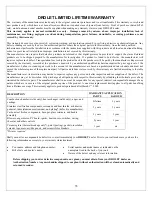
21
BLOWERS AND PRESSURE SWITCH PROBE
DANGER: RISK OF ELECTRIC SHOCK. DISCONNECT POWER BEFORE
SERVICING UNIT.
•
Blower Cleaning –
Over a period of time, ashes or dust may collect on the
blades of both the combustion/exhaust blower and convection blower.
Periodically, the blowers should be cleaned as the ash and dust can
impede performance. The combustion/exhaust blower can be accessed by
opening the left, right, and back panels.(Figure 25) To clean the blades in
the combustion housing, insert the vacuum tip through the air inlet damper
opening located on the side of the combustion housing. Clean thoroughly.
To clean the blades in the exhaust housing, use a screw driver to remove
the cleaning access panel located on the side of the metal box covering the
housing. Insert the vacuum tip through the cleaning outlet and clean the
blades thoroughly.
•
Pressure switch probe cleaning -
Ashes may accumulate on inside tip of
the pressure switch probe connector. Use a mesh pad or wire brush to
clean the connector and blow inside the tube to make sure it’s free of
obstruction.
NOTE:
When cleaning, be careful not to bend fan blades. Some stove owners lightly spray an
anti-creosote chemical on the fire to help reduce creosote formation within the stove.
PROBE CONNECTOR
Figure 25
Exhaust blower cleaning
CHIMNEY CLEANING
a.
Creosote Formation
– When any wood is burned slowly, it produces tar and other organic vapours, which combine with expelled moisture to form
creosote. The creosote vapours condense in the relatively cool chimney flue or a newly started fire or from a slow-burning fire. As a result, creosote
residue accumulates on the flue lining. When ignited, this creosote makes an extremely hot fire, which may damage the chimney or even destroy
the house. Despite their high efficiency, pellet stoves can accumulate creosote under certain conditions.
b.
Fly Ash
– This accumulates in the horizontal portion of an exhaust run. Though non-combustible, it may impede the normal exhaust flow. It should
therefore be periodically removed.
c.
Inspection and Removal
– The chimney connector and chimney should be inspected annually or per ton to determine if a creosote or fly ash build-
up has occurred. If creosote has accumulated, it should be removed to reduce the risk of a chimney fire. Inspect the system at the stove connection
and at the chimney top. Cooler surfaces tend to build creosote deposits quicker, so it is important to check the chimney from the top as well as from
the bottom.
The creosote should be removed with a brush specifically designed for the type of chimney in use. A qualified chimney sweep can perform this service. It
is also recommended that before each heating season the entire system be professionally inspected, cleaned and, if necessary, repaired.
To clean the chimney, disconnect the vent from the stove.













































